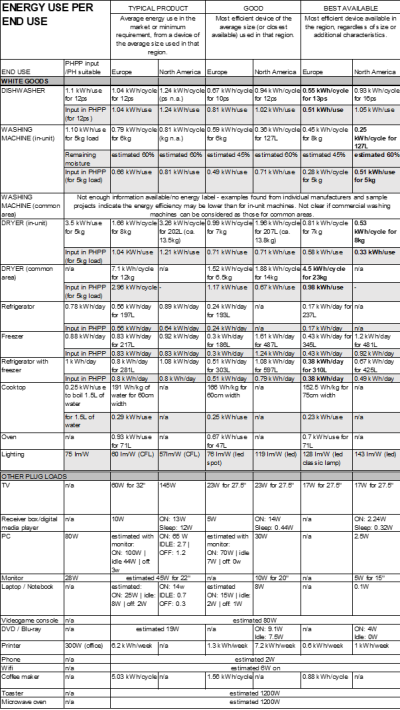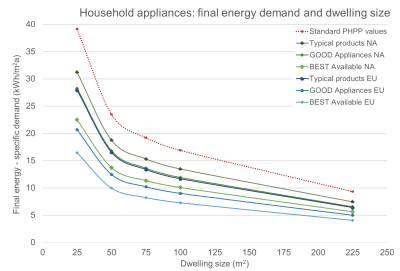This is an old revision of the document!
Table of Contents
Efficiency of household appliances and their impact on the primary energy demand of residential buildings
Once a project is designed as a Passive House, the energy demand from heating and cooling is drastically reduced. Then, the contribution of domestic hot water generation and household appliances becomes more relevant for the total primary energy demand of the building. At a household level, the energy demand from appliances (white goods) can be the largest share [Ottinger 2017]. It is then important to look at the efficiency of household appliances and how they can contribute to reducing the total primary energy use of a building. Even more so where projects are seeking to achieve the renewable primary energy requirements for Passive House Plus and Premium.
1 How is the energy demand from household appliances calculated in PHPP?
The energy demand from household appliances is determined in the “Electricity” Worksheet of PHPP. The annual energy demand is calculated based on the energy use of the appliances (norm demand as declared on energy efficiency labels), a reference size, and a given frequency of use. The reference size and frequency of use are fixed boundary conditions, while the norm demand can be changed. It must be noted that for certification, standard values for each appliance must be used, unless there is evidence that more efficient appliances have been installed. Figure 1 includes the example of the calculation for the sample project provided in PHPP and standard values for all appliances. For a more detailed description of the methodology, please refer to [Ebel 1997] and the PHPP Manual.
The use of standard values for certification provides a common framework to take into account their contribution to the overall energy performance of the building even if no information is readily available. That is often the case where buildings are handed over to the final user without any appliances, thus the design team has little or no influence on the selection of these devices. For the cases where the design teams can select efficient appliances, their contribution to improving the energy performance of the building can be represented in PHPP. The savings potential is significant, even in markets where the efficiency requirements for appliances are not as strict as the Ecodesign requirements in Europe. The next section includes an example of this, comparing the efficiency of available appliances in the German and the North American (Canada and the USA) markets.
2 Standard values in PHPP vs. declared energy efficiency of household appliances in different markets
In order to have a reference of the potential for reducing the primary energy demand through household appliances, the efficiency of readily available devices in the European and North American markets was compared to the standard values as set for PHPP 9. The research included the standard appliances in the “Electricity” worksheet of PHPP (washing machine, drier, refrigerator, freezer, combined refrigerator and freezer, cooktops, oven and lighting devices) as well as other plug loads that in PHPP are included under the categories “Consumer electronics” and “Small appliances” (e.g.: TV, PC or Laptops, Microwave oven). For each appliance, three values for the energy use were obtained:
- Typical product: refers to the average product in the market, based on international and national reports [IEA 4E, NRCAN] and, where no market reports were available, based on reference values from online databases of efficient devices [TOPTEN EU]. In the case of European appliances, the efficiency of the average product in previous years is already above the limit that is currently allowed. For those appliances, the maximum energy use allowed by the Ecodesign requirements was used instead.
- Good product: refers to the best product available in early 2019 in the given market, for the most commonly used type and size of appliance (or closest available) [TOPTEN EU, ENERGYSTAR].
- Best available: refers to the energy use of the most efficient device available in early 2019 in the region, regardless of size or other characteristics [TOPTEN EU, ENERGYSTAR].
The calculation in PHPP references to a given size for each appliance. If the appliances were of a difference size, then the energy use declared in the label must be scaled. For example, the energy demand of a washing machine is calculated assuming that each person will wash a 5kg load 57 times a year. If the project includes a washing machine of 8kg, the person may be able to wash more than one load in the same cycle. Then, if the washing machine has an energy demand of 1.66kWh/cycle, the energy demand to be entered in PHPP would be 1.66 x 5kg per load /8kg capacity = 1.04 kWh/use.
In addition, the standards or codes to determine the declared energy demand of the appliances are different from region to region or country to country. It is always important to understand these differences and how the norm values are obtained to make sure that they can be used for the calculation and to make a second conversion if needed. A conversion tool for values obtained from the EnerGuide and EnergyStar labels is already available [Peel 2019].
Table 1 includes the summary of the collected and normalized values per appliance. It must be noted that an exhaustive search of all available products in a given market was not carried out. As such, the values presented here cannot be considered statistically significant, and the authors make no claims that the products definitely represent the best available products in the different markets.
As Table 1 shows, there is not a clear tendency on whether appliances are more efficient in one region or the other. But, when looking at their contribution to the energy demand of the building, given the same utilization pattern, appliances available in Europe result in a lower energy demand. Figure 2 includes the final energy demand from household appliances for different dwelling sizes and with the values for the different regions and efficiencies. It must be noted that the average products available in both the European and North American markets already result in a lower energy demand than the one calculated with the standard values in PHPP. However, the total energy demand from the “best available” appliances in the North American market is still higher than that of the “good” appliances from Europe.
These scenarios also suggest that the energy demand from household appliances can be reduced by 50% or more if the best appliances available in Europe are used. For Passive Houses in particular, this means that installing very efficient appliances is a feasible path to get the renewable primary energy demand to the Plus and Premium levels. But, even if aiming at Passive House Classic, it makes sense to look at the efficiency of the appliances to be installed. This is even more important in regions like North America, where the average market values may be better that the standard values in PHPP, but very inefficient appliances are still available in the market. It is therefore always advisable to select appliances that are certified by energy saving programs (e.g.: EnergyStar) to prevent this.
3 The impact of different utilization patterns
Looking at the utilization patterns and potential for savings at the household level is strongly recommended, especially when the building has been designed for high energy efficiency. First experiences on evaluations at this level show the potential for savings is high (see more here). However, the available information on utilization patterns per appliance in the different regions is too limited to generate user profiles per region or country. But preliminary estimates do suggest that the average user in North America, and the USA in particular, will use more energy than the average user in Germany. Estimates also suggest that this difference may be due to consumer electronics and lighting.
In conclusion, results suggest that there is a tendency in both the North American and European markets of improved energy efficiency in the household appliances. To take advantage of these improvements, it is always advisable to select appliances that are certified by energy saving programs. It is worth mentioning that the calculation of the Internal Heat Gains for residential buildings already takes into account this improvement, guaranteeing that the very low heating demand achieved through Passive House is maintained even as older appliances are replaced by more efficient ones (see more here). A sensitivity analysis for increased IHG is in any case recommended to check their impact on the months where cooling is needed. This is particularly recommended if the use of inefficient appliances can be expected and even more so in small dwellings. In terms of the primary energy demand of the building, the calculation with standard values for household has proven sufficient for the design of a high quality building. Still, the use of efficient appliances results in a significant reduction of the total energy demand and should not be overlooked when selecting these devices.
References
| Ottinger 2017 | O. Ottinger; F. Gressier; M. Hohm; S, Peper: Electric Energy Efficiency for Households: The next step towards the NZEB, Tagungsband 21. Internationale Passivhaus-Tagung, Passivhaus Institut Darmstadt, 2017 |
| Ebel 1997 | Ebel, Witta: Methods of calculating electricity consumption in Passive Houses, Protokollband Nr. 7, Saving Electricity in Passive Houses, Passivhaus Institut Darmstadt, 1997. |
| Ecodesign | European Commission. List of energy efficient products Regulations: by product group. Retrieved from: https://ec.europa.eu/energy/en/list-regulations-product-groups-energy-efficient-products |
| IEA 4E | International Energy Agency. Mapping and Benchmarking Reports. Energy Efficient End-use Equipment. Retrieved from: https://mappingandbenchmarking.iea-4e.org/matrix?type=productreports |
| NRCAN | Natural Resources Canada. Energy Consumption of Major Household Appliances Shipped in Canada, Trends for 1990-2016. National Energy Use Database. Retrieved from: http://oee.nrcan.gc.ca/publications/statistics/aham/2016/index.cfm |
| TOPTEN EU | Topten International Group 2018. Topten-EU, Best Products of Europe. Retrieved from: http://www.topten.eu/english/services/about_topten.html |
| ENERGYSTAR | EPA. ENERGYSTAR Key Product Criteria. Retrieved from: https://www.energystar.gov/products |
| Peel 2019 | Peel Passive House Consulting, A Comparison of Canadian and European Energy Standards for Household Appliances. May 2019. Retrieved from: http://www.peelpassivehouse.ca/resources.html |
This article was developed in the framework of the “Project-specific PER” project. This project was administered by the Zero Emissions Building Exchange with funding from the City of Vancouver, Natural Resources Canada and the BC Ministry of Energy, Mines and Petroleum Resources.



